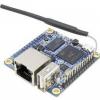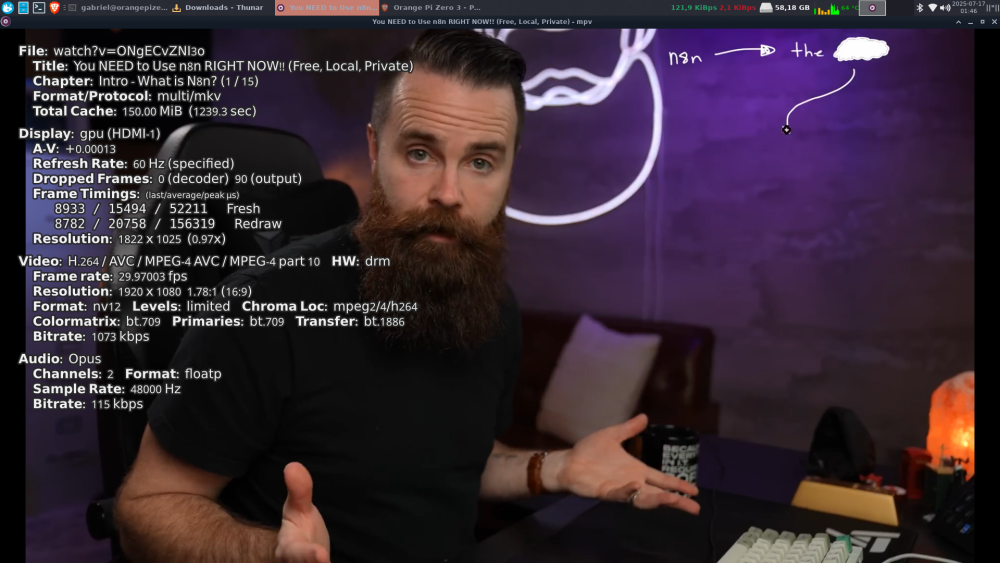All Activity
- Past hour
-
No, this board isn't supported. However anyone from the community can step up and add support for it. Found an attempt on Github:https://github.com/juanesf/build/pull/1
- Today
-
ah i see, sorry. is there armbian OS for Opi4A? i didnt found yet, on official page armbian, only for OPI4 and OPI4 LTs. thank you in advance
-
This is not an Armbian image. We do not support 3rd party images.
-
i used OPi4a then using image, but no one USB sound card working, lsusb found the device but not registered as sound device, alsamixer,pulse audio does not detect device. how to fix ? i'm using image : Orangepi4a_1.0.4_ubuntu_jammy_desktop_gnome_linux5.15.147 frome here : Gdrive
-
Hi Providing logs with PASTE_SERVER_HOST=paste.armbian.de armbianmonitor -u helps with troubleshooting and significantly raises chances that issue gets addressed.
-
moved
-
`ls /dev` is not showing mmcblk1. I have Armbian Ubuntu install that may have been messed around with and is not showing /dev/mmcblk1, where as a fresh uSCDCard install is.
- Yesterday
-
If you are having trouble with hardware decoding. You need to disable the compositor. Follow jock’s setup instructions in the link below. Use this command to restart xfwm4 with compositor disabled. killall xfwm4 && xfwm4 --compositor=off &
-
What did you do to fix it? Others that come across this may find it useful.
-
I believe I have installed all the components as mpv seems to detect ffmpeg-v4l2-request. Unless adding --no-audio I get complaints about hdmi audio failing. From what I can tell mpv is at least trying to run on the video engine but something is not right:mpv-log.txt From when I tested this once before I got errors relating not being able to reserve enough memory (-12). I guess I need to hunt for cedrus patches as well as lowering CMA buffer size which conversely in the past allowed me to run a desktop image without crashing at boot. In truth the A10 is so old now that it is likely the video engine on will ever be fully supported.
-
Hello, Setup Yocto branch: Kirkstone (honister back-ports disabled) Layers / commits meta-odroid 06f8d2c (last week’s master) poky kirkstone (bitbake 2.2.0) Kernel: linux = v5.15 What I changed so far Enabled the driver Added a linux-hardkernel_%.bbappend with: CONFIG_PWM=y CONFIG_PWM_MESON=y Patched the Device Tree (added a new layer to patch in yocto using devtool): From 9f296f4b8f636b12ef8c0a4720cf0d25d9eeb810 Mon Sep 17 00:00:00 2001 From: OpenEmbedded <oe.patch@oe> Date: Thu, 17 Jul 2025 15:50:18 -0400 Subject: [PATCH] some changes to source for pwm --- arch/arm64/boot/dts/amlogic/meson-gx.dtsi | 2 +- .../arm64/boot/dts/amlogic/meson-gxbb-odroidc2.dts | 14 ++++++++++++++ 2 files changed, 15 insertions(+), 1 deletion(-) diff --git a/arch/arm64/boot/dts/amlogic/meson-gx.dtsi b/arch/arm64/boot/dts/amlogic/meson-gx.dtsi index 32cc9fab4490..f7abfd4746d2 100644 --- a/arch/arm64/boot/dts/amlogic/meson-gx.dtsi +++ b/arch/arm64/boot/dts/amlogic/meson-gx.dtsi @@ -330,7 +330,7 @@ pwm_ab: pwm@8550 { compatible = "amlogic,meson-gx-pwm", "amlogic,meson-gxbb-pwm"; reg = <0x0 0x08550 0x0 0x10>; #pwm-cells = <3>; - status = "disabled"; + status = "okay"; }; pwm_cd: pwm@8650 { diff --git a/arch/arm64/boot/dts/amlogic/meson-gxbb-odroidc2.dts b/arch/arm64/boot/dts/amlogic/meson-gxbb-odroidc2.dts index 201596247fd9..0f5e52e7096c 100644 --- a/arch/arm64/boot/dts/amlogic/meson-gxbb-odroidc2.dts +++ b/arch/arm64/boot/dts/amlogic/meson-gxbb-odroidc2.dts @@ -416,3 +416,17 @@ &usb0 { &usb1 { status = "okay"; }; + +&pwm_ab { + status = "okay"; + pinctrl-names = "default"; + pinctrl-0 = <&pwm_a_x_pins>; +}; + +&pinctrl { + pwm_a_x_pins: pwm_a_x { + groups = "pwm_a_x"; + functions = "pwm_a_x"; + bias-pull-disable; + }; +}; Symptoms modprobe pwm-meson dosen't loads, nothing in dmesg. But the file are here : root@odroid-c2:~# dmesg | grep pwm root@odroid-c2:~# ls /sys/class/pwm* pwmchip0 root@odroid-c2:~# ls /sys/class/pwm/pwmchip0/ device export npwm power subsystem uevent unexport root@odroid-c2:~# modprobe pwm-meson root@odroid-c2:~# dmesg | grep pwm root@odroid-c2:~# ls /sys/class/pwm/pwmchip0/ device export npwm power subsystem uevent unexport root@odroid-c2:~# echo 0 > /sys/class/pwm/pwmchip0/export root@odroid-c2:~# ls /sys/class/pwm/pwmchip0/pwm0/ capture duty_cycle enable period polarity power uevent /sys entries: /sys/class/pwm/pwmchip0/ ├── export ├── npwm ├── device ├── power ├── subsystem ├── uevent ├── unexport └── pwm0/ ├── freq0 ├── duty0 └── enable0 I run (root): root@odroid-c2:~# echo 20000000 > /sys/class/pwm/pwmchip0/pwm0/period root@odroid-c2:~# echo 1500000 > /sys/class/pwm/pwmchip0/pwm0/duty_cycle root@odroid-c2:~# echo 1 > /sys/class/pwm/pwmchip0/pwm0/enable but nothing happen. Questions Has anyone successfully driven hardware PWM on the C2 with current meta-odroid + Kirkstone? Any known quirks with the pinctrl or the pwm-meson driver on kernels ≥ 5.15? Sample DTS snippet or working .bbappend would be greatly appreciated! Thanks in advance. Krum
-
After enabling the rk3588-hdmirx overlay in armbian-config device tree overlays, whenever I boot, I am greeted with multiple hdmirx (fdee0000.hdmirx-controller: hdmirx_wait_lock_and_get_timing HDMI pull out, return!) errors on boot. On a previous install, the hdmirx errors would block the entire boot process and it would just hang forever. I do not know the exact cause, but the issues seemed to arise after I ran this command to disable the X Display Server "systemctl set-default multi-user.target". The errors could only be resolved if I plugged in the sd card into another device and removed rk3588-hdmirx from overlays in /boot/armbianEnv.txt . I have since reinstalled Armbian, but the errors still appear during the boot process, however now they do not block the boot process and I am able to successfully boot into Armbian. Is there any solution to get rid of these errors, or ensure that the "fdee0000.hdmirx-controller: hdmirx_wait_lock_and_get_timing HDMI pull out, return!" error doesn't block the boot process without disabling hdmirx? These are my current device details: .. orangepi@orangepi5-plus `:]x**j-,' ----------------------- .,+t***********z\<" OS: Armbian 25.5.1 noble aarch64 ?******************; Host: Orange Pi 5 Plus '*n` .'`^,;;,^`'. ,cc. Kernel: Linux 6.1.115-vendor-rk35xx -<. .[l Uptime: 30 mins // ^^ ^^ \\ Packages: 1822 (dpkg) !^ ^^ ": Shell: bash 5.2.21 'tt}` !~]rj_ ")t/. Display: 3840x2160 @ 60 Hz Itttt?' ~~]rr] `{tttt, DE: KDE Plasma 6.3.90 \tttttt!""I_]r("""~tttttt1 WM: KWin (Wayland) '_tttttttttttt)ftttttttttttti. WM Theme: Breeze \*ztttttttttttttttttttttttttf**[ Theme: Breeze (Dark) [Qt], Yaru [GTK3] l**c)tttttttttttttttttttttttt(z**, Icons: breeze-dark [Qt], Yaru [GTK3] .z*x.`tttttttttttttttttttttttt.`u*n Font: Noto Sans (10pt) [Qt] >` (tttttttttttttttttttttt] "I Cursor: breeze (24px) ,tttttttttttttttttttttt` Terminal: konsole 25.4.1 ./tttttfttttttttfttttt( CPU: rk3588 (8) @ 2.40 GHz 'I)))(\()(tt))|\()({;' GPU: Mesa Mali-G610 (Panfrost) .~~~~~~~|)~~~~~~~< Memory: 4.34 GiB / 15.58 GiB (28%) '[)))))1|()))))))? Swap: 0 B / 7.79 GiB (0%) ",,," ",,,^ Disk (/): 7.82 GiB / Here is the dmesg log after boot up, the hdmirx errors appear near the end: boot_errors.txt
-
I have a Odroid N2+ whose SD card holder doesn’t seem to work. I have a Supervised HA installation on Debian 12 bookworm booting off a USB HDD. I want to move to armbian with Supervised HA pre-installed. Can I use a USB SDD with the image written on it, boot from it and do a full install on the same SDD?
-
I'm reopening this old 3D because I figured out why some of you had the problem of only seeing 1GB (about 800MB free RAM) on a 2GB board. I didn't have the problem simply because I never bricked my board and didn't need to flash the firmware. After bricking the board, I also had the RAM problem and realized it was due to the firmware, probably on a board with 1GB of RAM. If anyone has a link to the firmware for a 2GB board, I'll explain the solution I found. It involves loading Armbian ophub onto a USB stick and using the full eMMC restore with the saved image armbian-ddr command, of which I have a copy. This way, the board reverts to the factory Android image loaded on the eMMC, and Linux sees 2GB of RAM. I don't know the technical reason for this, but I think the emmc image contains some sort of BIOS that precedes the loading of uboot and the board's dtb. After restoring the original emmc image, the tx3 logo returned; it was no longer there with the other firmware. Soon the link of my image with 2GB ram for fake tanix tx3mini with soc S905L2-B so if anyone is still playing with this board can see the 2GB of ram again.
-
tried mining feathercoin, git clone https://github.com/ghostlander/cpuminer-neoscrypt lots of missing dependencies to build that apt install automake autoconf-archive pkg-config libtool libcurl4-openssl-dev but once done it is autogen.sh, configure, make next register on https://www.mining-dutch.nl/ then run ./minerd -D --algo=neoscrypt --url=stratum+tcp://mining-dutch.nl:9993 -u username.worker1 -p d=10 a whopping 1.1 k hash/s on each core, well not very impressivve, but it mines i think this is no Neon SIMD Stop monitoring using [ctrl]-[c] Time CPU load %cpu %sys %usr %nice %io %irq Tcpu C.St. 20:22:02 1416 MHz 3.90 100% 0% 0% 99% 0% 0% 53.2 °C 0/7 20:22:07 1416 MHz 3.91 100% 0% 0% 99% 0% 0% 53.2 °C 0/7 20:22:12 1416 MHz 3.92 100% 0% 0% 99% 0% 0% 53.4 °C 0/7 ^ this is with the fan on optimise it a little in makefile #CFLAGS = -g -O2 CFLAGS = minerd_CPPFLAGS = -O3 -mcpu=cortex-a53 -march=armv8-a -ftree-vectorize -funsafe-math-optimizations well, just a very minor 0.025 k hash/s improvement per core. perhaps it already has Neon SIMD or that it needs 'hand optimization', that is hard.
-
@robertoj well, Neon SIMD isn't just useful for that matrix math, it is useful e.g. as a video decoder/encoder in place of specialized on chip video hardware. it could partially explain the 'better performance' of mpv (https://mpv.io/) e.g. if mpv is after all built with -o3 or that mpv uses a library that is optimised iwth Neon SIMD, it could likely practically see a performance as the on-chip proprietary video hardware which is not publicly documented. with an apparent 100% cpu usage if all 4 cpu cores are used with Neon SIMD. I think I once chanced upon an Rpi forum comment about shifting the codes to Neon SIMD instead instead of using propietary video hardware, partly as these 'small' chips has 'limited' capabilities for on chip video processing etc. it isn;'t really a bad thing if after all we'd use say an Opi Z3 as a 'dedicated' video streamer. A thing is at 100% cpu, non compute threads may struggle to get a slot to run at times, it may take setting 'nice' levels so that some threads get a higher priority. I've been thinking about running a (crypto coin) miner on it, probably would do that some time. They certainly don't get close to say even a Haswell, or Ryzen or even a 'low end gpu' but that they are faster than the 'older' 'smaller' chips for a comparison, the quoted 'old' figures https://linux-sunxi.org/Benchmarks#Linpack -mcpu=cortex-a8 -march=armv7-a -mfpu=neon -mfloat-abi=hard -funsafe-math-optimizations -fno-fast-math Memory required: 315K. LINPACK benchmark, Double precision. Machine precision: 15 digits. Array size 200 X 200. Average rolled and unrolled performance: Reps Time(s) DGEFA DGESL OVERHEAD KFLOPS ---------------------------------------------------- 16 0.61 88.52% 6.56% 4.92% 37885.057 32 1.21 85.12% 2.48% 12.40% 41459.119 64 2.43 93.83% 2.47% 3.70% 37561.254 128 4.86 91.77% 2.47% 5.76% 38381.368 256 9.70 92.06% 2.89% 5.05% 38173.000 512 19.41 91.29% 2.47% 6.23% 38634.432 mcpu=cortex-a8 -mtune=cortex-a8 -march=armv7-a -mfpu=neon -mfloat-abi=hard -funsafe-math-optimizations -fomit-frame-pointer -ffast-math -funroll-loops -funsafe-loop-optimizations Memory required: 315K. LINPACK benchmark, Double precision. Machine precision: 15 digits. Array size 200 X 200. Average rolled and unrolled performance: Reps Time(s) DGEFA DGESL OVERHEAD KFLOPS ---------------------------------------------------- 16 0.53 90.57% 1.89% 7.55% 44843.537 32 1.05 90.48% 3.81% 5.71% 44390.572 64 2.13 90.14% 2.35% 7.51% 44615.905 128 4.23 90.54% 3.07% 6.38% 44390.572 256 8.46 90.19% 2.84% 6.97% 44672.596 512 17.03 90.55% 2.76% 6.69% 44250.892 vs that above is like 8x - 10x improvements on a single core
-
Good afternoon! I bought a server home assistant. The web used to open. the interface is at 192.168.1.141:8123, and now it’s reaching armbian and I don’t know what to do next and I don’t understand why this happened either. I’m asking for your help. Has anyone ever had such a situation? If I created the wrong theme, can you tell me where to create it, or maybe there is already such a theme?
-
Hi, is there currently support for NVMe storage in Armbian trunk? I tried to flash the latest build, added nvme ssd storage - but it is not seen in the system. What to check?
-
@1-igor I followed your guide, I ereased the spi flash. But after rebooting the OPi 5 wont even boot to the previously working ssd m.2. Even no orange pi screen before boot. Is there any fix? No longer needed. Fixed.
-
For those who are seeking to enable video decode i've been able to get it working with those libs https://www.elektroda.pl/rtvforum/topic4018092.html#20840047 download h618_hwdec.tar.gz and replace the libs and add "extraargs=cma=256M" to your /boot/armbianEnv.txt , mpv works flawlessly with --hwdec=drm --profile=fast, scrcpy is also fast and with minimal cpu usage... i'm also using rolling edge kernel, and latest 25.2 mesa from source libva-v4l2-request-HACK_HEVC.zip






.thumb.jpeg.7f1c1049f75c982201fd5770f50521b3.jpeg)



